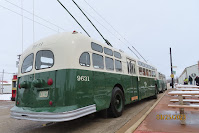Lots of exciting things are happening at the Museum, and here's a snapshot of just a few of them from Thursday.
Tracks 41 and 42
When I arrived early in the morning, I immediately noticed that track 41 had been connected through the barn, as seen here. It was installed over the past two days by the contractors, and today they started on track 42.
This is really mainline quality workmanship.
In the morning, roadbed for 42 was dug out and leveled, then they started filling it with rock ballast.
And rails were still going into place when I left.
1808
Tim was mostly working on curved ceiling panels, which are made in two layers glued together. Here he is starting to spread the glue, as Phil looks on.
Later, we have two sections in the big press while the glue dries.
When installed, they look like this:
And he also spent time stripping the long molding strips for the ceiling.
306
Phil, a recent recruit, spent most of the day cutting and installing new floor parts, as seen here.
And John was working on the many new door panels.
460
Some of the second shift guys recently wire-wheeled the baggage racks for the smoker. The racks are big and heavy, and their help is much appreciated. Since there was no good way to spray them in the shop areas, I moved them back into the smoker with help from Phil, and I was able to warm it up enough for painting. The racks will probably require some touch-up, as it's hard to see or spray all of the various surfaces on such a complicated construction.
Most of my time was spent finishing up the inner side of the smoker-vestibule door, more or less. Stripping this paint is a real chore.
And then I turned it over, with help from John. The other side isn't much better, and I might as well do it all at the same time.
And that's not even all that's going on in the shop. As usual, you had to be there. And that's no joke.
























































